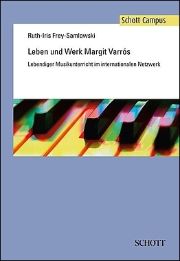The piano teacher Margit Varró
Ruth-Iris Frey-Samlowski is known for her countless reports from conferences and congresses. She died far too early on June 17, 2014. In the last fourteen years of her life, she worked intensively on the life and work of the Hungarian piano teacher Margit Varró, whose textbook "The Living Piano Lesson" is still relevant and useful. Her dissertation was published in 2012.

See also Main article on reforms to music teaching in Switzerland in the 1930s.
The review copy of the dissertation has only now reached the editors, but not too late in view of its importance. Because what has been known about Varró up to now was either written in Hungarian or was very incomplete, even partly incorrect. The intensive research into every detail of the dissertation has been worthwhile. And where they were unsuccessful, the author conscientiously indicates this. It is true that she found it difficult to distinguish the important from the unimportant. However, she facilitates clarity by including 41 tables on Varró's teachers, fellow students, concerts with venues, programs and performers, as well as concerts by her students, her courses, lectures and publications, etc. 89 illustrations, many of them previously unpublished, including color ones, adorn the 471-page book and make it reader-friendly, so that the essentials are easy to find.
Margit Varró, born in 1881 (or 1882?), grew up in a Jewish family with German origins and colloquial language and studied at the Liszt Academy in Budapest, where she found her four colleagues and friends, Kodály, Bartók, Dohnányi and Leó Weiner, and taught piano didactics until 1921. As Bartók's advisor, she played a major role in the conception and realization of his Mikrokosmos. Since the publication of her main work in German, translated into French and Hungarian and still required reading in piano didactics at German-speaking music academies today, she became internationally known and traveled throughout Europe to give lectures, courses and teaching rehearsals until she had to emigrate with her family to the USA in 1938, where she remained professionally active to the same extent until almost the end of her life in 1982.
A brief overview of her textbook will suffice here. Piano lessons are an education of the musical sense and understanding, and also include ear training, the teaching of elementary knowledge of music, harmony and form, always in connection with the thorough recognition and feeling of the subject matter to be worked out technically on the piano, as well as - crucially - improvisation. She propagated both individual and group lessons. Beginners' lessons are best started without sheet music by singing, playing and accompanying suitable folk songs; she was of course thinking of the Hungarian-Romanian treasure trove that was being explored at the time. During and after the gradual introduction of reading music, memorizing all the teaching literature (!) is essential. The technical part includes a section on the hidden music-medical and psychological causes of playing disorders, their diagnosis and treatment, as well as a section on practicing, always with lesson examples. The psychological section, one third of the textbook, contains a wealth of suggestions that cannot be expanded on here.
Back to the author of the dissertation: She studied piano as a major subject with music education, as well as German and English language and literature (state examination), with postgraduate studies in philosophy and history. Lifelong further education was important to her. Most recently, she completed a degree in musicology. In addition to giving private lessons, she founded and ran a music school in Hagnau on the northern shore of Lake Constance based on her own music education concept (children and adults), where she also gave additional lessons on the clavichord, which were beneficial for children. Every year, she was able to successfully prepare several particularly talented students for entrance examinations to music academies. She was regularly invited to participate in the Saarbrücken working group for piano pedagogy led by Werner Müller-Bech. She then became a lecturer in music education, didactics and classroom music-making at the conservatories in Detmold, Frankfurt/M and Zurich. In addition, she held countless courses and guest lectures and gave and organized concerts at home and abroad. The list of her publications comprises 158 numbers. She was torn from her varied, restless activities by a short, incurable illness.
Ruth-Iris Frey-Samlowski, The Life and Work of Margit Varrós. Living music education in an international network, 474 p., € 59.95, Schott, Mainz 2012, ISBN 978-3-7957-0768-2








